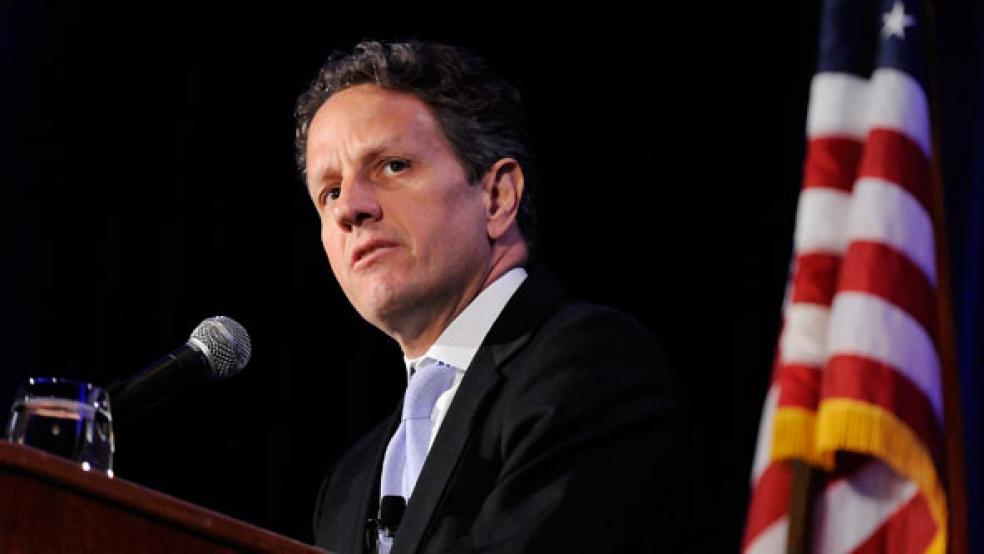In his book, Stress Test: Reflections on Financial Crises, former U.S. Treasury Secretary Timothy Geithner muses over the bailout of the financial system during the 2008-09 financial crisis. He concludes not only that, however flawed, the Troubled Asset Relief Program (TARP) was a “best of all possible bailouts,” given the constraints of contemporary politics and law, but also that it has ultimately been justified by the fact that it has made money for the American government and taxpayer. Both of these conclusions are inaccurate.
While the first no doubt will continue to be the subject of debate for many years to come, the second is nothing short of a weak apologia, featuring an incomplete assessment of the collateral damage of the bailouts, including the enormous costs to Americans that don’t appear directly on the government’s balance sheets.
Related: Geithner Says Saving Big Banks Was the ‘Moral Thing to Do’
As both Stress Test and his actions as Treasury secretary have made clear, Geithner believes that the financial institutions of advanced economies are of far greater importance than all other sectors of the economy. This is wrong thinking. Yes, during the crisis, the banks had to be propped up and kept open by government; the depression that would have followed a true collapse of the system would have unquestionably led to an economic nuclear winter far worse than what we actually experienced. But the notion that saving the banks could not have been done through means other than that of the few-strings-attached TARP is a specious one, at best.
The simple fact is that we are sorely in need of the de-financialization of our economy. The U.S. financial services sector today as a percentage of our GDP is more than twice what it was in 1980, and nearly four times as large as it was in the 1950s. And, it has not shrunk since the financial crisis, but actually has grown larger, to the point that it is now about 9 percent of our GDP.
Geithner’s faith in the efficiency and effectiveness the large banking institutions (and in the structures of capital formation in the United States and other advanced nations) is misplaced. And unfortunately, measures to reduce the cost to the economy of financial intermediation by sharply reversing the deregulatory and consolidation bias that existed before the crisis have to date been insufficient; oftentimes, during Geithner’s tenure, they only occurred — by his own admission in Stress Test — over his initial objections.
A Full Accounting
Where Geithner gets it really wrong, though, is in his “green eyeshade” calculus that the bailouts have been profitable to the U.S. taxpayer. In making this claim, he only looks at the amount of money the government spent as part of the $700-plus billion TARP effort and at the funds recovered from the institutions that were bailed out. By that simple measure, yes, the U.S. government is in the black today.
Related: Geithner’s Insult ‘A Badge of Honor’ – TARP Top Cop
The truth, however, is that the financial sector bailout was far larger than TARP, or anything else that came out of the Treasury Department during or since the crisis — and most of it came via the policies of the U.S. Federal Reserve.
Few of the enormous profits the financial services industry has enjoyed since the crisis — profits that enabled the much-touted repayments of TARP — came from the particular effectiveness or business acumen of financial institutions, but rather were the result of an often overlooked gift to the banks: the massively reduced cost of capital that banks have enjoyed as a result of actions by the Fed. This cheap capital came at the expense of more prudent savers, who have seen interest rates on lower-risk bank deposits and government obligations fall to historic lows.
In effect, Fed action resulted in a huge transfer of earnings from savers to banks and other corporations for which cost of money is a major expense. This has been the real bailout, and no analysis of the effectiveness of TARP is meaningful without understanding the true cost of these policies.
First, banks profited enormously from the Fed’s zero interest rate policy, which still prevails.
Since the Fed reduced short-term interest rates to near-zero in December of 2008, banks have enjoyed the ability to borrow at the lowest costs in history. In pursuing its three rounds of quantitative easing, the Fed has acquired longer-dated Treasury obligations at a profit to the banks. It has even rewarded banks with interest on the huge excess reserve balances that they have amassed from those purchases, even though banks have not been able to lend out those funds due to the insufficient loan demand that has characterized the lackluster recovery since the crisis. Trillions of dollars of excess liquidity generated by quantitative easing has bid up the so-called secondary markets (stock and bond markets), boosting the value of banks’ legacy (pre-crisis) assets — even as new capital formation and investment has remained anemic.
Second, during the crisis and immediately thereafter, financial institutions received generous support from the Fed, in the form of trillions of dollars of financial risk that was assumed by government.
In the finance world, central banks have long been regarded in crisis situations as the “lenders of last resort” — willing to step in and lend when private capital holders are in panic. But since the 19th century, when Walter Bagehot first laid out his rules of lending by central banks during financial panic, it has always been generally accepted that central banks should provide emergency lending only at a substantial premium (for very short periods of time and with a high interest rate) in order to prevent the moral hazard of undue risk-taking by banks in expectation of an easy bailout.
During the recent crisis and its aftermath, just the opposite occurred. Recent research has shown that the Fed lent trillions of dollars to the 20 “primary dealers” that were eligible to borrow under emergency programs such as the Term Auction Facility (December 2007-March 2010), Single Tranche Open Market Operations (March 2008-December 2009), the Term Securities Lending Facility (March 2008-February 2010), and the Primary Dealer Credit Facility (March 2008-April 2009). Cumulative borrowings under these facilities totaled some $17.7 trillion, and the money went out at a weighted average interest rate of 1.5 percent, hardly the punitive premium rates prescribed by Bagehot. Moreover, much of this lending, as detailed above, went on for years. This was not just emergency intervention, but rather the furnishing of a crutch.
A Boon for Big Banks
Collectively, these policies amounted to stuffing enormous earnings into the fewer and larger financial institutions that survived the crisis. And this leaves aside the regulatory forbearance that banks have enjoyed since the crisis, enabling them to avoid liquidating hundreds of billions of dollars in bad assets and incurring losses.
The former Treasury secretary’s self-congratulatory “victory lap” for TARP is therefore only half right at best. Looking narrowly, the repayment of TARP recouped the government’s funds, but this has come at huge cost to savers in lost interest, and through outsized rewards to the financial sector and its managers relative to the benefits of the sector to the economy. Geithner’s assertion of “being right” about TARP ignores this larger picture.
And now, an apology of my own.
In November 2008, during the interregnum between the Bush and Obama administrations, I went on television and made numerous statements, to both press and colleagues, vigorously endorsing Geithner for the post of Treasury secretary. I felt at the time that his experience as a young American technocrat in Japan, his presidency of the Federal Reserve Bank of New York, and his being at least one generational half-step removed from his mentors, former Treasury Secretaries Larry Summers and Robert Rubin — who in my opinion had been off on any number of issues during the decade prior to the crisis — made Geithner a relatively apolitical but still government-tempered candidate well suited to the job. I was wrong.
Daniel Alpert is Managing Partner of Westwood Capital, LLC, a fellow in economics at The Century Foundation, and the author of The Age of Oversupply: Overcoming the Greatest Challenge to the Global Economy.
Top Reads from The Fiscal Times:





